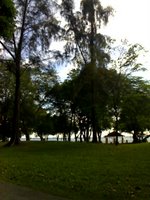This trip to Labrador Park has given us the opportunity to venture outdoors to relate what we have learned in the topic of Coastal Studies, Weathering and Natural Vegetation to the field and we also observed the coastal/marine processes at work there. We also had a chance to interact with our own classmates and find out more about them.
The first location we went to was the Aerial Tower. As we journey down the staircase from the Aerial Tower to the Jetty, I recalled what have been taught in the topic of Natural Vegetation a few months ago. I find it easier to understand what we have learned by looking at the real things rather than just simply reading from the notes or looking at the 2D pictures in it. The leaves in the forest were indeed thick and leathery and smooth and waxy with downward pointing drip tips. Buttress roots were also found. The trees grow very closely to one another, forming a continuous canopy so we were actually sheltered from the sun. The condition inside the forest was hot and humid. The forest floor was dark with lots of leaf litter lying around and little undergrowth was found there. A lot of ants and insects were found in the forest and I saw algae on our way down which I find it surprising. Lianas and a few species of climbing plants were also found in the forest. Methods of soil conservation were also practiced there.
The second location we went to was the Jetty/Rocky Beach. It was lucky for us that we went there during low tide. We saw the wave-cut platform, which is only exposed during the low tide. It was a gently sloping coastal land surface that extends towards the sea from the foot of the cliff. The Rocky Beach was indeed rocky and filled with rocks, with bigger rocks nearer to the foot of the cliff and smaller rocks further away. The beach materials were indeed sorted on the beach. There was a construction of jetty going on. A notch was found at the foot of the cliff. I did not know that it was a notch until Miss Chee pointed it out. Initially I thought that the notch was just an ordinary hole. Further erosion of the notch would make it further enlarged and form a cave. Maybe 50 years later, we would get to see a cave in Labrador Park!
The third location we went to was the Promenade. The coastal protection method used along the Promenade was the building of seawalls. Actually, I have seen seawalls around in Singapore at East Coast and Sentosa in the past few years, but it is just that I did not know how a seawall looks like till this trip to Labrador Park. Building of seawall helps to reduce the effect of the waves and helps to reflect the waves away from the coast. However, building of seawalls have its own disadvantages, powerful backwashes of the reflected waves increase the rate of erosion of the beach materials and also causing the base of the seawalls to weaken resulting in the continuous rebuilding of the seawalls again and again. There are groups of anglers fishing along the Promenade too.
The last location we went to was the Dragon Teeth Gate. The type of rock that is found there is the granite rock. Biological weathering and chemical weathering mainly attacked the type of rock found there. There is evidence of oxidation taking place due the reddish-brown iron oxide that is present on the surface of the rock. The roots of the plants attacked the lines of weaknesses of rocks found there. Remnants of the past like the war relics, tunnels and a fort are also be found there.
Lastly, Labrador Park is one of the few Singapore's nature parks around in Singapore so it is very important to preserve the natural environment in our urban landscape. It is our responsibility to protect and conserve it. Also, Labrador Park is not just a normal park in Singapore. Visitors especially the history and geography students get to observe what they have learned more clearly.
Thursday, November 30, 2006
Subscribe to:
Post Comments (Atom)

No comments:
Post a Comment